|
|
Post by Zen on Dec 29, 2010 0:05:55 GMT -6
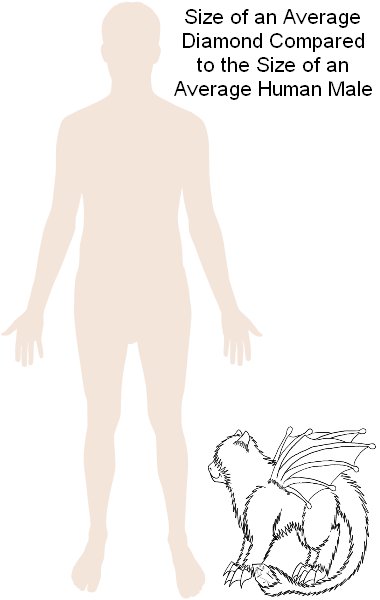 Comparison of the different colors' average sizes in relation to each other. 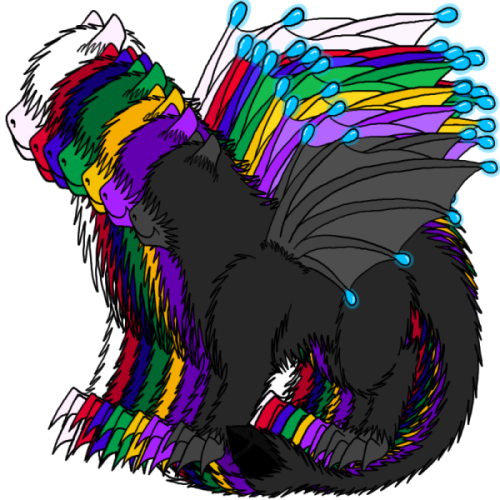 Gemtails are a fairly recent discovery as they seem to be native only to the northern part of the Western Continent’s Greater Western and live mainly underground besides. The miners of Jask Cothold first discovered the creatures about five Turns ago and set traps so that they could be caught and transported for study by Beastcrafters and Harpers. They have not found out everything there is to know about the creatures yet, not by far, but this is what is known:
- The largest Gemtails are about the size of a domestic feline. They are covered in thick fur except on their headnobs, snouts, frills, and feet, which all seem to have the same texture as dragon skin. Their reproductive and excretory organs are located at the base of the tail, before the tail splits around the gem. Their bodies are rather compact, their snouts short, in order to conserve heat in their native colder climate.
- They have about the same telepathic communication abilities as Firelizards; they are able to communicate with their bonded through pictures and feelings, and also have the ability to pick up a stray word here and there, though their ability to relate those words to what they actually mean varies, and some might just say the words for the sake of showing off, which can get rather annoying. Generally, the higher the color the more likely they are to actually know what they're saying.
EX:
A Diamond, Ruby, Sapphire, or Emerald might be owned by a dragonrider and hear the word 'dragon' spoken many times in reference to their owner's dragon or others. They will understand that this word 'dragon' is referring to those huge winged beasts they've been seeing, and might even be able to learn the name of their owner's dragon and be able to connect it to said dragon. However, a Topaz, Amethyst, or Onyx might just pick up the word dragon, or their owner's dragon's name, from hearing it over and over and say it in some attempt to impress their bonded without ever actually knowing what it means.
- They are rather social and hierarchal creatures and in the wild live in groups of varying sizes, called Troops. Each Troop is led by a Diamond and her mate and territorial fights between Troops occur often.
- The main reason they leave their tunnels is to have mating Runs, not unlike Whers, however the first male to catch a female remains her mate for life and will not chase any other female, nor will any male chase a female that has previously mated. The only exception to this is if one mate died, then the living mate would be able to chase/be caught by a new Gemtail. Mating Runs always occur at night. A mating Run has little to no effect on a Gemtail's bonded other than the fact that their bonded will know it is happening.
- Despite their fur leading one to believe otherwise, they hatch from eggs which are laid one month after mating. The eggs are kept warm by the bodies of their mother and other Troop members, rather than heated sands. Upon hatching two sevendays after being laid the hatchlings are ‘nude’ and have no fur to speak of. Slowly over the next sevenday the fur will grow in.
- When their fur first grows in it is very soft, silky, and as they age they grow a courser overcoat that further helps them to keep warm in the northern climate they’re native to.
- They bond with the first one to touch the gem on their tail and give them a name (this means the first word you say when touching their gem is what they will answer to which has led to some very odd names in the past, before this knowledge was known). This gem does not begin to form until they have consumed enough nutrients, generally shortly after their first sevenday after hatching, after the food they consume is no longer going fairly strictly toward growing fur.
- Wild adults will still bond a human even after Turns of living wild, so long as no other human has gone through the bonding process with them yet. However it is harder to bond wild adults because mature Gemtails are notoriously protective of their gems and will not let anything or anyone get near them easily, even scratching and biting to keep others away from their gem. If their bonded dies they will return to the wild and will never re-bond.
- The gem on their tail grows very slowly, but continuously, throughout their lives and never stops until death. If the gem is removed before natural death occurs (which can only be accomplished by cutting the end of the tail off) then the Gemtail will die immediately.
- They eat a wide variety of items including minerals found in a variety of rocks, tunnelsnakes, and any scraps their owner might choose to feed them. It is unknown at this time if there is much of anything they won’t eat. Their lower jaw is slightly oversized and extremely strong, stronger than that of a dragon’s or whers even, and so there doesn’t seem to be anything they couldn’t eat if they really wanted to.
- They do not have a second stomach and are not able to flame.
- They have the same copper-based ichor as dragons, whers, and firelizards.
- Their claws are extremely tough, so much so that they are able to dig into solid rock.
- They do not appear to have eyes and instead ‘see’ heat registers. In the darkness of underground tunnels one supposes there is little use for eyes. They also seem to have an incredible sense of smell. Their frills also appear to be quite sensitive to air currents and pressure and they are able to sense subtle changes that alert them to dangerous underground areas.
- Gemtails are very quiet creatures and rarely make any sounds, though they have been heard to make certain quiet clicks and squeaks at times and may let out a high pitched squeal if surprised or in danger.
- Gemtails are active at all times of the day. They take short naps throughout the day rather than sleeping for one long period of time.
- Like dragons, tunnelsnakes, whers, firelizards, and many other Pernese creatures, Gemtails have 3 pairs of limbs, four legs and in place of wings they have expressive bioluminescent frills. These frills do not have strong muscles and cannot do more than enable a slightly longer leap or slow the descent of a fall; as Gemtails spend most of their lives underground it is not necessary to fly. Instead, Gemtails are able to move these frills in a wide variety of ways according to their mood, much like a canine does with their ears. They also pulse different colors according to their mood like the eyes of dragons, whers, and firelizards.
-blue: content, neutral
-green: happy, excited
-yellow: frightened, surprised
-orange: annoyed, suspicious
-red: angry, hungry
-purple: love, lust
-white: sad, worried
-pale, dull grayish: sick, dying
|
|
|
|
Post by Zen on Dec 29, 2010 0:20:48 GMT -6
Gemtail Colors Gemtails come in a variety of colors that give them certain rank with other Gemtails like dragons, whers, and firelizards; so named for what the gem on their tail looks like. 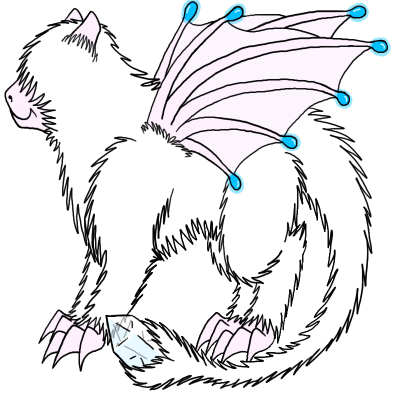
Diamond
The largest of the Gemtails and the rarest, making up less than 1% of the Gemtail population, Diamonds are always female. Their fur is pure white while their skin is tinted ever so slightly with color and the diamond-like gem on their tail sparkles and reflects a multitude of colors. They are the Queens of the Gemtail Troops and all other Gemtails in a Troop will obey a Diamond without fail. There is only one Diamond in a Troop and if two Diamonds meet they will fight to the death and the loser’s Troop will join the winner’s. The fierce combative nature between Diamonds contributes to their rarity. Diamonds are fiercely protective of their young during their first sevenday of life and will not leave them for any reason or let anything or anyone else near them except to bring her and them food. After their first sevenday she will allow others near and it is at this point that they can be handed out to those who wish to bond with one.
A Diamond will tolerate her Diamond daughter for only one month before she chases her out of the Troop. However, even at such a young age, the Diamond is sure to survive because a certain number of adult Rubies, Sapphires, and Emeralds are sure to follow her in the hopes of becoming her mate and leading a new Troop with her, and they will all protect her and teach her how to fend for herself. Owners of Diamond Gemtails will need to keep a close watch on them, especially if another Diamond is in the vicinity. They are quite the handful to own and are not recommended as pets to any but experienced beastcrafters or the rare trader who can be sure she won’t get herself killed in a fight against another Diamond.
Size Range: 30-36 inches
Runs: For the first time at 9 months and a little more than once a Turn after that.
Caught By: Rubies, Sapphires, Emeralds.
Clutches: up to 10 eggs, max of 1 Diamond (rare), 2 Ruby/Sapphire/Emerald (only the color of the father, 1 more commonly), 2 Topaz, 3 Amethyst (2 more commonly), the rest Onyx.

Ruby
Together with Sapphires and Emeralds, Rubies make up about 15% of the Gemtail population, or about 5% on their own. They are always male and can be any shade of red, while their tail gem varies very little from one Ruby to the next, usually a slightly pinkish red or a slightly darker blood red. Rubies are the overseers of the others, making sure they are all doing what they’re suppose to and the inner workings of the Troop are running smoothly. They seem to be about the same rank as Sapphires and Emeralds. They can be quite bossy, even with their bonded, and are very hard to train. They cannot abide idleness and if their bonded is looking to simply relax they will not allow it and will rouse them by any means possible. Overall they can be quite hard to live with unless you’re used to sleeping in short periods throughout the day.
Size Range: 26-32 inches
Chases: For the first time at 8 months.
Catches: Amethysts, Diamonds.

Sapphire
Together with Rubies and Emeralds, Sapphires make up about 15% of the Gemtail population, or about 5% on their own. They are always male and can be any shade of blue, while their tail gem is generally only a deep, dark blue in color with very little variation. Sapphires are the ‘royal guard’ of their Diamond queen. Most Sapphires in a Troop will stay near her, regardless of if she is their mate or not, and will not let any other Gemtails near her without her permission. Sapphires are very protective of their bonded and will rarely leave them for very long. They can be a bit too protective at times and will not allow many others near unless their bonded impresses strongly upon them that certain others should always be allowed near and are not a threat.
Size Range: 25-31 inches
Chases: For the first time at 8 months.
Catches: Amethysts, Diamonds.

Emerald
Together with Rubies and Sapphires, Emeralds make up about 15% of the Gemtail population, or about 5% on their own. They are always male and can be any shade of green, while their tail gem is generally a dark green in color with a possibility to be slightly lighter or darker than average. Emeralds are the generals of the Troop. It is the Emeralds that lead the others to battle against other Troops, fighting on the front lines, ready to help their smaller ‘soldiers’ if they are having trouble and making the decisions to push forward or retreat. Emeralds are the cleverest of the higher male colors, the most intelligent, and the most likely to use strategy rather than brute strength. They are known to be scrappy pets and will just as frequently tussle with a canine or firelizard as with strange Gemtails. They are quite brave and small groups of them are starting to be used as ‘watch Gemtails’, for they will attack intruders to their territory without question.
Size Range: 24-30 inches
Chases: For the first time at 8 months.
Catches: Amethysts, Diamonds.
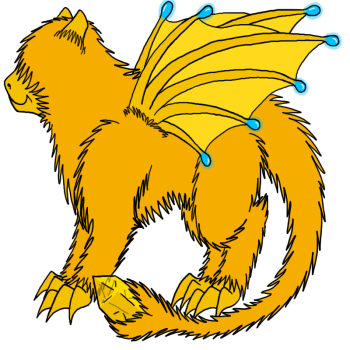
Topaz
Topaz Gemtails are always male and make up about 20% of the Gemtail population. They range in color from pale yellow to a darker, golden orange and their tail gems vary in the same way. Topaz Gemtails are very curious and are the explorers and scouts of the Troop. They are sent out to explore newly discovered tunnels and to gather information on other nearby Troops. They are generally obedient but are known to wander if left to their own devices, though they will always return and sometimes bring random trinkets back with them as presents for their bonded.
Size Range: 20-24 inches
Chases: For the first time at 7 months.
Catches: Amethysts.
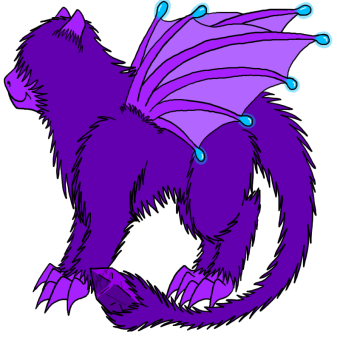
Amethyst
Only slightly more common than Topaz Gemtails, Amethysts make up about 25% of the Gemtail population and are always female. They come in varying shades of purple and the gem on their tail can vary just as much, even being numerous shades of purple at once. Amethysts are very nurturing and motherly, but not as protective of their young as Diamonds. They are more likely to let others approach their young earlier and will leave them for short periods of time even before their first sevenday of life, which is good because their clutches don’t get special treatment from the Troop like Diamond clutches do and their young would likely starve if they didn’t bring them food back themselves. Only an Amethyst’s mate will help her care for their young until they can forage for themselves. Amethysts are the ones that watch over the Diamond’s clutch when she isn’t there herself. They are quite patient and friendly with their bonded and enjoy cuddling, which is making them popular among women and children.
Size Range: 18-22 inches
Runs: For the first time at 6 months and twice a Turn after that.
Caught By: Ruby, Sapphire, Emerald, Topaz, rarely Onyx.
Clutches
Amethyst x Ruby/Sapphire/Emerald – up to 6 eggs, max of 1 Ruby/Sapphire/Emerald (VERY rare, only the color of the father), 1 Topaz, 1 Amethyst, the rest Onyx.
Amethyst x Topaz – up to 5 eggs, max of 1 Topaz(rare), 1 Amethyst, the rest Onyx.
Amethyst x Onyx – up to 4 eggs, max of 1 Amethyst (rare), the rest Onyx.

Onyx
Onyx is the smallest and most common type of Gemtail, making up roughly 40% of the Gemtail population. They are always male and have a pure black, opaque gem on their tails. Their fur and skin varies from pure black to a smoky grey. They are the drudges of Gemtail society. It is their duty to constantly bring food to the ruling Diamond and her newly hatched young during their first sevenday of life and bring food back for the clutch for about another two months after as well, until they are old enough to begin foraging with the rest of the Troop. The Onyx variety of Gemtail is a very agreeable sort and will rarely disobey or protest any action of their bonded, which is making them popular with children. Onyx Gemtails rarely ever chase and it is even rarer for them to actually catch a female, though not impossible.
Size Range: 14-18 inches
Chases: For the first time at 5 months, if they even chase at all.
Catches: Amethysts (VERY rarely).
|
|
|
|
Post by Zen on Jan 1, 2011 17:10:17 GMT -6
Here you can find a record of all the Gemtails at Western. The owner of the Gemtail will be listed beside them.
Diamond
Ruby
Sapphire
Emerald
Topaz
Amethyst- Violet - Brete
- Sweety - Fala
Onyx |
|









